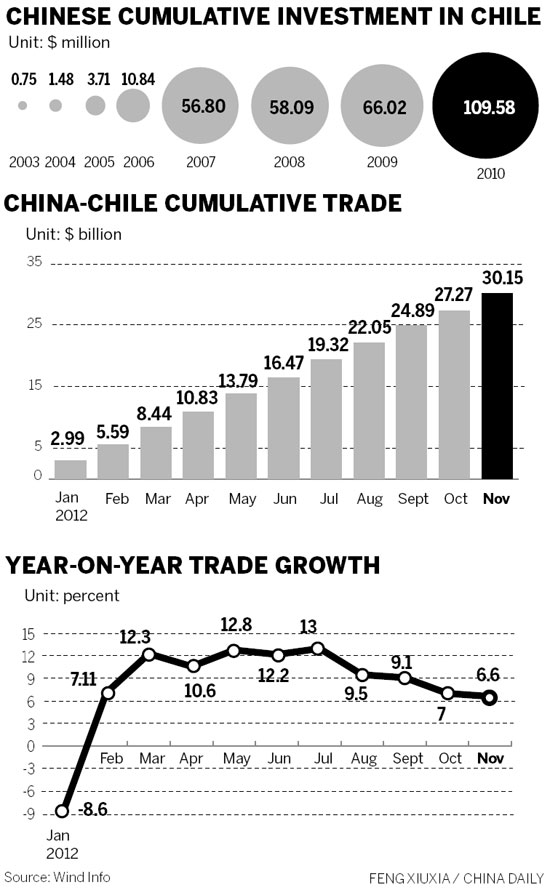Latin America offers way out of demand doldrums: Official
Updated: 2013-01-08 07:55
By Ding Qingfen in Santiago (China Daily)
|
||||||||
|
Quality control employees conduct a final inspection at Great Wall Motors Co Ltd's assembly plant in Tianjin. Chinese automobiles hold a 12 percent share of the Chilean market, according to Yang Wanming, Chinese ambassador to Chile. Provided to China Daily |
Region holds 'good opportunities' as weakness in mature markets persists
As the demand from developed markets, especially the European Union, decreases sharply, Chinese companies should be encouraged to export goods to Latin America, says Yang Wanming, Chinese ambassador to Chile.
"Latin America is now a strategically important market for China ... especially amid the European debt crisis," he said.
While China's foreign trade with some developed economies remained weak in 2012, "the rate of increase between China and Latin America ranged from 12 to 15 percent. That's a remarkable rate," he added.
According to the General Administration of Customs, China's exports from January to November last year surged by 7.3 percent year-on-year, down sharply from the year-on-year growth of 21.1 percent in the same period of 2011.
In the first 11 months of 2012, China's foreign trade increased by 5.8 percent from a year earlier, well below the central government's target of 10 percent for the year.
The deceleration was largely a result of the European debt crisis, which has dampened demand in the EU, China's chief trade partner. In November, China's exports to the EU fell by 18 percent from a year earlier, showing their sixth straight monthly decline.
Yang said Latin American countries can "provide Chinese companies good opportunities to increase their exports".
"Latin America is highly market-oriented," he said. "Various countries, led by Brazil, Mexico and Chile, have seen their economies grow rapidly during the past few years."
The International Monetary Fund predicted Peru, Chile and Brazil will show the strongest economic growth among Latin American countries from 2013 to 2017. Peru's economy is expected to grow by 6 percent during the period, Chile's by 4.6 percent and Brazil by 4.1 percent.
In 2011, Brazil, the largest economy in Latin America, surpassed the United Kingdom to become the world's sixth largest economy. It is expected to be the world's third-largest automobile market by 2015.
The Brazilian government recently predicted China will become its largest source of imports this year.
"The value of China-Brazil trade is expected to surpass $80 billion this year," said Yang.
China has signed various free trade agreements with Latin American countries, including Chile and Peru.
From January to August, China's exports to Peru increased by 16.5 percent, and to Chile, by 15.5 percent, according to the Ministry of Commerce.
Yang noted that China-Chile trade stood at $2.1 billion in 2001 and has since shown an annual growth rate of 30 percent, hitting more than $34 billion in 2011.
"Three years ago, we didn't see any Chinese cars in the streets of Chile," he said. "But now, Chinese car makers hold a 12 percent share of the market. It's an amazing change, isn't it?"
Experts say Latin America complements China in many ways.
"It has abundant land, mining and energy resources, and China has a lot of manufactured goods that they need. It's a good match," said Zhang Yansheng, secretary-general of the National Development and Reform Commission's academic committee.
But he also has concerns. "We are far away from each other, which makes business exchanges more difficult to arrange than with other places," Zhang added. "And the political instability in the region and cultural differences also pose difficulties to Chinese exporters."
For Latin American countries that either rely greatly on mineral goods or are trying to diversify their exports, China's gigantic market and its rapid growth are attractive attributes, he said.
China is the largest export destination for Brazil, and also the largest for Chile.
China's exports have been on the decline since the latter half of last year, although they increased by close to 10 percent in September. Yet that recovery has inspired little confidence in the nation's export prospects.
Chinese manufacturers are now facing their most difficult circumstances since the financial crisis and have been calling on the government to expand shipments to emerging markets.
"Latin America plays a essential role in helping China stabilize its exports growth and sustain economic growth," said Yang.
As Chinese exports increase, Latin American countries have been directing more trade protectionist measures against Chinese products.
Countries such as Mexico, Argentina and Peru are at the forefront of those efforts. So far, Peru has initiated 25 trade remedy cases, including 22 anti-dumping cases, against Chinese imports.
"Trade investigations have concentrated on steel and iron products, textiles and rubber goods, and the means used have been diverse," said Yu Benlin, deputy director of the Ministry of Commerce's Bureau of Fair Trade for Imports and Exports.
"We have to say the situation is quite severe."
Highly complementary
"We can see there is huge potential that trade (between China and Latin America) will surge," Yang said. "We complement each other in many categories."
China and Chile's economic ties have been greatly strengthened, especially since the countries signed a free trade agreement that came into effect in 2006.
Under the agreement, 92 percent of Chile's exports to China are tariff-free. The figure will increase to 99 percent by 2015, and about 97 percent of Chinese exports to Chile will be exempt from tariffs by the same year.
China has been the leading export destination for Chile since 2007, according to official figures.
In 2000, bilateral trade had a value of less than $20 billion. By 2011, the figure was up to $34 billion.
The value of Chilean exports to China amounted to $17.9 billion in 2011. That amount accounted for 22.2 percent of the country's gross exports and was up 7.67 percent from 2010 and 42.78 percent from 2009.
China mainly imports mining and energy goods and agricultural products from Latin America, and exports mechanical and electrical goods, telecommunications goods and services, garments and shoes.
"China mainly exported light industry goods, but the categories of telecommunications goods and high-tech goods were later added," he said.
"Besides energy and mining goods, China is also buying more agricultural goods."
One of China's main imports from Chile has long been copper, to which fresh fruits and wine have been added.
China is the largest importer of fish meal from Chile, the sixth largest importer of wine and the ninth largest importer of fruits, according to Chinese statistics.
Xie Yu in Shanghai contributed to this story.
dingqingfen@chinadaily.com.cn

(China Daily 01/08/2013 page13)

 In Photos: 7.0-magnitude quake hits Sichuan
In Photos: 7.0-magnitude quake hits Sichuan
 Li Na on Time cover, makes influential 100 list
Li Na on Time cover, makes influential 100 list
 FBI releases photos of 2 Boston bombings suspects
FBI releases photos of 2 Boston bombings suspects
 World's wackiest hairstyles
World's wackiest hairstyles
 Sandstorms strike Northwest China
Sandstorms strike Northwest China
 Never-seen photos of Madonna on display
Never-seen photos of Madonna on display
 H7N9 outbreak linked to waterfowl migration
H7N9 outbreak linked to waterfowl migration
 Dozens feared dead in Texas plant blast
Dozens feared dead in Texas plant blast
Most Viewed
Editor's Picks

|

|

|

|

|

|
Today's Top News
Live report: 7.0-magnitude quake hits Sichuan, heavy casualties feared
Boston suspect cornered on boat
Cross-talk artist helps to spread the word
'Green' awareness levels drop in Beijing
Palace Museum spruces up
First couple on Time's list of most influential
H7N9 flu transmission studied
Trading channels 'need to broaden'
US Weekly

|

|








